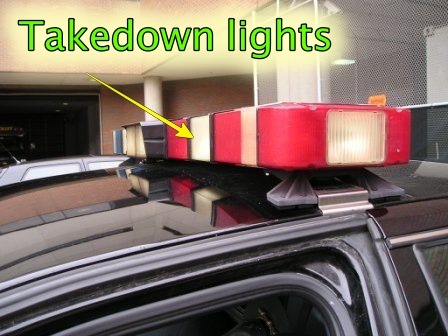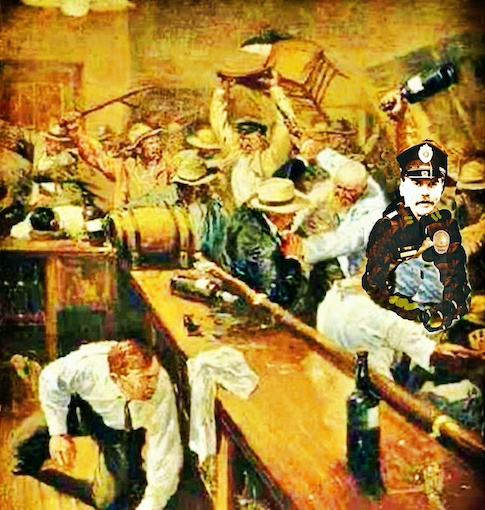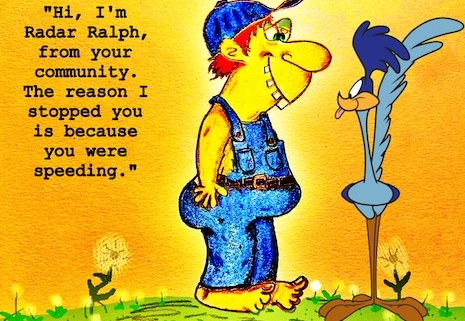Domestic and neighbor disputes, and traffic stops are only three circumstances where officers often face extreme danger and sometimes death.
Even seemingly nonviolent situations, such as loud music complaints, serving civil process (summons and other court papers) can quickly transform into a life or death situation for officers, especially when alcohol and/or drugs are involved at the source of the complaint.
I know first-hand just how quickly and unexpectedly violence can erupt at each of the above scenarios. Actually, one of the worst fights for my life came about at the scene of a loud music complaint, but that’s story for another blog article.
Yet, many people are demanding that those types of calls be answered by unarmed community members with backgrounds in social work, mental health, and/or as victim advocates. Sure, I’ll be the first to agree that in some instances a mental health provider or one of the other community members skilled at social work would be a fantastic asset, and that those folks could help calm some individuals into a state that could negate the use of force.
Domestic Disputes
Domestic violence calls are dangerous for responding police officers. The situation has already exploded before they arrive. Tempers and emotions are at their peaks. Children and other family are often in the home when the violence erupted. Pets are frightened and excited. Neighbors sometimes gather outside the home.
Normally, suspects in violent crimes flee before the police arrive; however, at the scenes of domestic violence calls it’s typical that both the perpetrator and the victim are present, which creates a unique situation for responding officers. To add to the chaos, it’s not unusual that the victim decides to physically defend the husband, even after calling 911 for help.
I, like most officers, have been in my share of tussles. But one of the the hardest hits I’ve received was delivered by a woman who, when I tried to handcuff her husband for beating her, she nailed me in the head. She’d been crying and telling me how badly she was treated. How regular the beatings had been. How she was a prisoner in her own home. And how frightened she was. Too frightened to leave.
When I placed her husband under arrest, he resisted and we went a round or two before I finally managed to getting a cuff on one of his wrists. Then, out of nowhere and before I could hook the other wrist, I was blindsided with what felt like a cinder block. That little lady and her bony fist caused me to see the “bright light” we often hear about.
Once the female version of Mike Tyson join the scuffle, I was then struggling with two violent people. He was trying to flee and she was pummeling me with everything in her arsenal, from fists and fingernails to knobby knees, sharp elbows, and bare feet, all while screaming, “Run, Honey Biscuit, run!” Fortunately, another officer and a civilian arrived to assist, and in short order both “Honey Biscuit” and his lovely wife were in handcuffs.
Replacing Police with Civilian Social Workers
Sending lone, or even a team of social workers into a violent domestic dispute is akin to using a water pistol to battle a raging California wildfire. As I stated above, I know what it’s like to step inside a home where the wife is battered and bloody, children are crying and screaming, all while the husband, soaring high on meth and who knows what else, is pacing about the house holding a loaded shotgun in one hand while punching holes in the walls and doors with the other.
At that point, once the drugs, alcohol, adrenaline, extreme anger, and roiling emotions have sent him over the cliff, there’s no collection of feel-good, sing-songy words that will stop this person. They’re violent and wild and are likely to seriously harm someone.
This is a man who simply is not rational and often sees any outsiders as a threat and often acts accordingly, by attacking, shooting, taking family members as hostages, etc.
No, this is not a situation that should be handled solely by a unarmed social worker who’s never been in a physical confrontation. And if they haven’t, well, they’re about to learn the hard way what it’s like to tangle with a person who feels no pain and who’s as strong as an angry bull on steroids.
Please don’t misunderstand, though. I’ve seen instances where people other than police were precicely the right people to talk the violent person down. Sometimes a female officer is a better choice than a male officer, or the other way around. But not every violent person would greet a responding social worker with open arms and a nice cup of tea.
Yes, I have no doubt there will be some success stories, and I hope there are many. Of course, truth be known, there are a vast number of happy endings involving police officers that occur each day. Unfortunately, it’s the unhappy stories that make the headlines.
My fear is for the social worker who enters the wrong house at the wrong time to face a person who’s determined to harm or kill someone. It’s a roll of the dice as to who lives or who dies, because the worst will happen at some point. Bet on it. At least police officers are trained to handle themselves during physical confrontations.
Traffic Stops
There’s no other feeling in the world like stopping a speeding car with dark, tinted windows and loud music with its bass rumbling so hard you feel it in your chest before you step outside the patrol car. Add to the scenario, a moonless night on a lonely stretch of highway with not a single house in sight. Backup is twenty minutes away, should you need it.
Your spotlight cannot penetrate the dark window tint making it impossible to see if there’s one person inside, or four, or six. No idea if the occupants are armed, wanted, or simply a couple of teens out for a drive in the country.
The bass thumps, rattling and shaking the car’s muffler. The vehicle wiggles and shakes a bit—someone’s moving around. But you can’t see where they’re located in the car. Again, how many people are inside?
You form a plan.
With all of your lights on—spotlight and takedown lights—to provide a bit of blinding cover, you decide to approach the car slowly from the passenger side, hoping for the element of surprise

Thump, thump, thump goes the bass, and your heart.
Thump. Thump. Thump.
You knock on the window.
Thump. Thump. Thump.
Then, nothing.
The music stopped.
Silence.
Your hand automatically reaches for the gun holstered to your side. The grips and cool blue steel are slightly comforting.
The thumping is soon replaced by night sounds—frogs, crickets, and buzzing mosquitoes who’re attracted to the compounds released in your breath and from the pearls of sweat careening along your spine. Your forehead and the space just beneath your eyes are peppered with tiny dots of perspiration. Nervous sweat, as my grandmother would say if she were still with us.
The passenger side window slowly creeps down a couple of inches. You pause slightly before aiming the beam of your Maglite inside to take a peek. That’s when you see the young man who’s gripping the steering wheel with both hands. He’s alone and cooperative. His license, registration, and insurance are all valid. He apologizes for speeding, explaining that he was nearly late for curfew and wanted to make it home in time so his parents wouldn’t yell at him.
Your heart rate, now normal, the fear/pucker factor gone, and with the nervous sweat disappearing, you let the kid go with a warning. As the car pulls away you release a lung-emptying sigh of relief knowing the situation could have been a polar opposite, with the driver setting up to kill a police officer.
Nighttime traffic stops are not for the faint of heart. I’d rather wade into a nasty bar fight any day.

I was a field training officer (FTO) way back during my time working in the patrol division. It is the FTO’s duty to supervise new officers who’ve recently graduated a police academy. FTO’s provide on the job training until the rookie officers meet necessary criteria and are able to take to the streets on their own.
One Wednesday morning, around 7 a.m., I, and the rookie who was working under my tutelage, found ourselves behind a car that was slowly swerving back and forth between the yellow center lines of the city street to the white line separating the travel lane from the bike lane. Several times the vehicle crossed each of the lines.
The rookie was driving while I sat in the passenger seat observing. Still a bit unsure he asked if I thought he should stop the car. I quickly said, “Yes, unless you want to see a horrible crash unfold in real time.”
So the officer-in-training activated the emergency equipment (lights and siren). The swerving car pulled to the side of the road, stopping with the right front tire on the sidewalk. A drunk driver, no doubt. At 7 o’clock in the morning.
The rookie approached the driver’s window and asked the man behind the wheel, a large guy who appeared to be in his sixties, to present his license and registration. I stood at the passenger side window watching the man fumble through the glove compartment and patting his pants pockets at least seven or eight times before declaring, in a slurred manner of speech that nicely complimented his bloodshot eyes and breath that reeked of sour corn liquor, “I ain’t got no license.”. Drunk as a skunk, he was.
The rookie asked the driver to step outside, which he did.
The rookie asked if he’d been drinking, which he admitted. In fact, he emphasized that he’d consumed quite a bit of moonshine.
I moved around to the driver’s side in case problems arose, and my cop’s sixth sense was telling me to prepare for the worst.
The rookie told the guy he was under arrest and to turn around and place his hands behind his back.
This is where things became interesting because the moment the rookie grabbed the “old guy’s” wrist and arm for handcuffing, the man turned his body toward the rear of the car, in my direction. The next thing I saw was the rookie’s body go up and over the car’s rooftop, down the trunk lid, and finally to the pavement. The “old guy” was so strong that he’d used only one arm to send my young partner on the quick flight. So, of course, I grabbed the man and hung on for a terrifying ride that even Disneyland couldn’t replicate.
After we were finally able to apply handcuffs and gain control of the extremely strong senior citizen, we learned that he worked for a logging company as a laborer handling pulpwood—large trees and/or logs that’re used to manufacture paper products such as cardboard. The long sleeve shirt he wore did a great job of concealing arms the size of small tree trunks and muscles as hard as stone.
No, I do not recommend that unarmed mental health providers or other non-police conduct traffic stops. They can be deadly, and sometimes result in serious harm or death of the person conducting the stop.
Again, it’s a roll of the dice. Will it be the next driver stopped by the citizen traffic patrol who’s wanted for murder and will kill anyone who slightly resembles “authority,” or will it be the kind old bookstore owner who wouldn’t harm a flea?
Here’s how quickly things can go wrong during a “routine” traffic stop for speeding.
*Please, I beg you to not post political, racial, anti-cop, or other hot button comments. This is a factual article based on actual experiences. I worry about the safety of social workers, mental health providers, victim advocates, and citizens conducting traffic stops, responding to domestic and neighbor disputes, the folks who may someday find themselves facing life threatening circumstances such as the one in the video above. I guarantee you that bad guys will never play by the rules.


